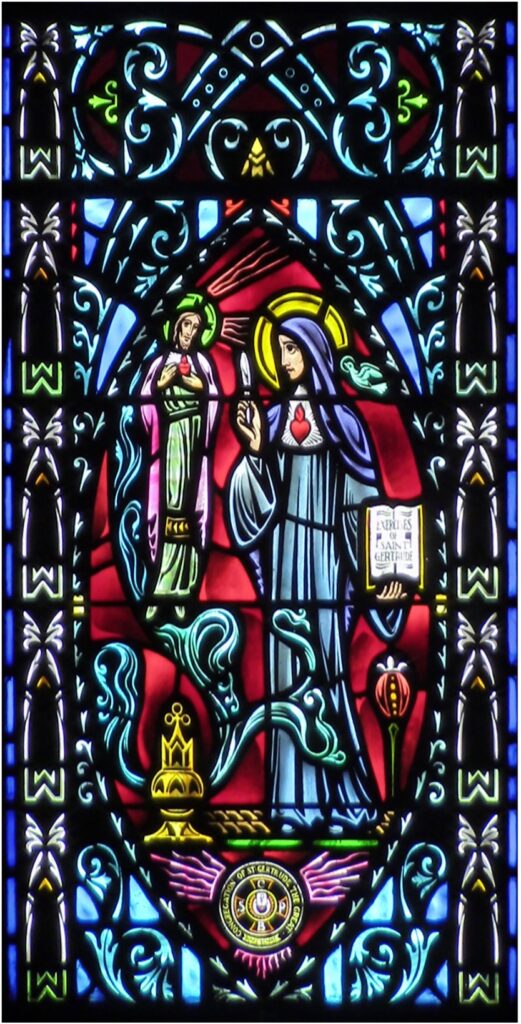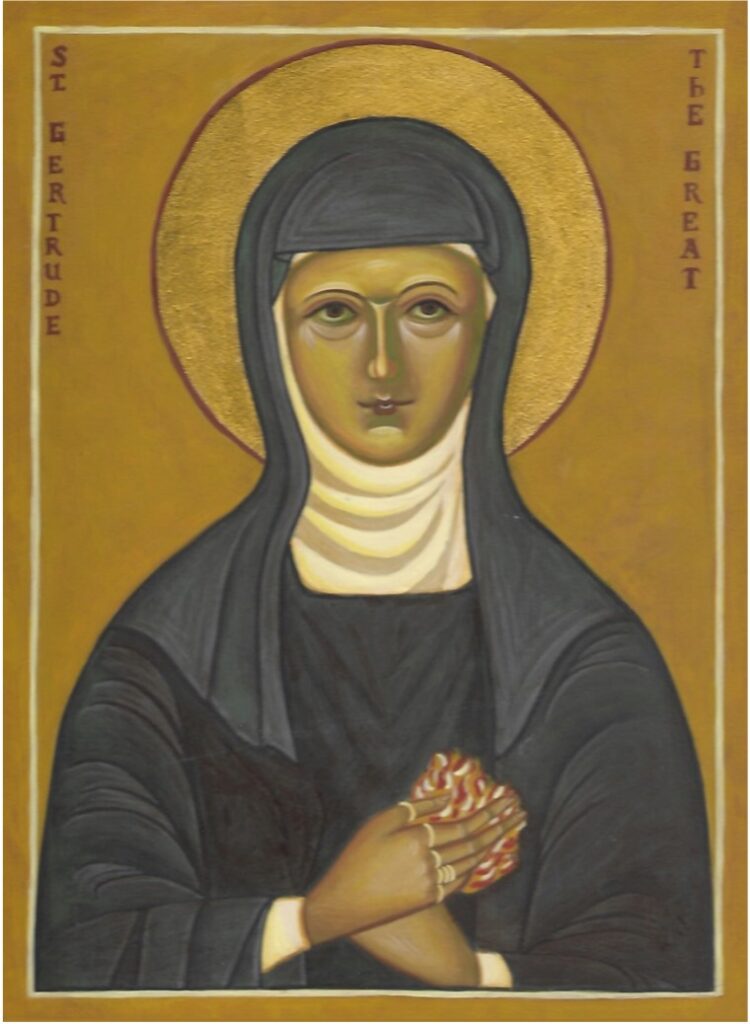About Saint Gertrude
Saint Gertrude was born in Germany on the Feast of the Epiphany, January 6, 1256. Beyond this one fact of her birth, we know nothing of the first five years of her life. But in 1261 Abbess Gertrude of Hackeborn, of the Benedictine abbey at Helfta in Saxony, admitted the child as a pupil in their school.

No family name is recorded for Gertrude, and no reason is given for this omission. Some have speculated that she was a child oblate offered to the Church by devout parents. However, in her writings, Gertrude refers to herself as an orphan. She may have been displaced during the political chaos and civil strife of her time. Or she could have been disowned because of some other event or circumstance hidden in the history of the thirteenth century. For whatever reason, Gertrude was placed in the care of Abbess Gertrude. Mechtilde of Hackeborn, younger sister of the abbess, was the teacher when Gertrude joined a small group of children at the abbey school.
The nuns of Helfta have left us their memories of Gertrude as a loveable, quick-witted child who responded immediately to the gracious disposition of Mechtilde and later chose her as a confidante. Throughout her school years, she proved to have such clarity of perception and depth of understanding that she often surpassed her classmates in her studies. The curriculum at the convent school was strong, and the students were challenged to learn grammar, rhetoric, logic, and Latin. Gertrude also revealed a knowledge of music and practical arts like spinning and weaving.
Although we don’t know the reason why Gertrude was brought to Helfta, we do know that Gertrude entered the community upon completion of her studies at age 15 or 16. As a novice in the Benedictine community, she received instruction in liturgy, scripture, the Rule of Benedict, patristic and other spiritual writers of the monastic tradition. After making her monastic profession, she applied herself to the study of literature and directed much of her energy to writing fluent Latin and German. She was strong in character and personality and, as a teacher in the school, became a life-giving presence in the community which numbered about 100 women during her lifetime.
The Helfta community did not regard Gertrude as an overly pious young woman. And Gertrude confides that she was so engrossed in her studies that she may have neglected her spiritual calling. By the time she was 24, she was beginning to find the routines of the monastery tiresome. During the Advent season of 1280, she endured a severe trial of emotional storm and spiritual distress which left her depressed and withdrawn. Shortly after her 25 birthday, on January 27, 1281, Gertrude experienced a sudden and unexpected encounter with the risen Christ, which she calls her “conversion.” In her deepest heart she heard Christ say to her, “Do not fear. I will save you and set you free.” This was the first in a series of visions which led her into mystical prayer and ultimately transformed her life. She decided to give up her literary studies and devote herself to prayer and the study of scripture. From then on, she spent many hours reading and copying texts of scripture and sometimes writing short reflections on the word of God to share with others.
In 1289, Gertrude heard Christ ask her to write an account of the many graces she had received. At first Gertrude resisted, believing that it would serve no purpose. When she was told that such writing might serve to encourage others, she consented. In Latin, Gertrude wrote a short spiritual autobiography to which the Helfta community later added all the information they had about her. This composite is known today as THE HERALD OF GOD’S LOVING-KINDNESS. Only the 24 chapters of Book Two of THE HERALD are Gertrude’s own writing in which she witnessed to the spiritual transformation she had experienced. Carefully, Gertrude describes her awakening to the depths of her own heart. This awakening made Christ so real for her that she was able to overcome all resistance within herself and gradually move toward unconditional surrender to God’s love. There is little of conscious art in this book as Gertrude pours out the praise and gratitude she feels in beautiful scriptural images that arise spontaneously from within her heart.
Saint Gertrude also wrote her SPIRITUAL EXERCISES in Latin some time after 1289. We presume that she intended this thematic arrangement of prayers, hymns, and reflections for the nuns of her community. Gertrude herself used portions of them for her own yearly spiritual renewal. She also may have adapted them for persons who came to her for counsel. But the importance of the SPIRITUAL EXERCISES extends to the present day because they are grounded in themes and rites of Church liturgy for occasions of Baptism, conversion, commitment, discipleship, union with God, praise of God, and preparation for death. Gertrude’s SPIRITUAL EXERCISES may be used by anyone who seeks to deepen spirituality through prayer and meditation.
Saint Gertrude belongs to the late 13th century monastic culture and may be the leading woman writer and visionary of that culture. She is among those special voices from the past that address all Christians now at the dawn of the third millennium. She recalls us to a new awareness of God’s unconditional love for all creatures in the saving mission of Jesus. For us, she represents a serious and mature Christian spirituality essentially based in the scriptures and nurtured in the liturgy. Gertrude’s understanding of God’s love is anchored in the mystery of the mutual love between the Persons of the Blessed Trinity, which is forever directed toward all creation.

Gertrude’s mystical prayer is Christ-centered and the humanity of Christ is imaged as the Sacred Heart, the divine treasury of grace. Never does she lose sight of Jesus who comes as both divine and human. But for Gertrude, the focus on the mystery of Jesus turns less on his historical life and more on the humanity he shares with all humans. Her emphasis is not so much that we should imitate Jesus, but that we are invited to participate in a human-divine union that already is. In prayer and sacrament, we encounter this blessed union.
In her mystical prayer, Saint Gertrude experiences in the Church an intense love of the Eucharist, a loving embrace of the sinner, friendship for the outcast, and an enduring trust in God’s mercy. As Gertrude matured, her eyes opened to the mystery of Christ’s love in the Church and to its evangelizing mission in the world.
Saint Gertrude was never formally canonized, but a liturgical office of prayer, readings, and hymns in her honor was approved by Rome in 1606. The Feast of St. Gertrude was extended to the universal Church by Clement XII in 1738 and today is celebrated on November 16, the date of her death in 1301 or 1302. Pope Benedict XIV gave her the title “the Great” to distinguish her from Abbess Gertrude of Hackeborn and to recognize the depth of her spiritual and theological insight.
